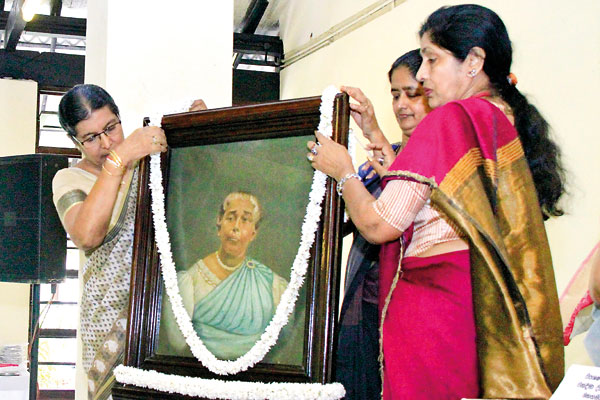News
Elderly population set to double by 2041, women to outlive men, says expert
View(s):Tiny-tots all in white going in perahera around the hall set off the right chord for an annual general meeting (AGM) that has been held for 96 years.
As the members, all female and one male, of the Mallika Nivasa Samithiya (Society) Ltd., arrive right on time for the 97th AGM on Thursday, the little children and the elderly women walking around in the garden depict what this stalwart society established in 1920 is all about.

Prof. Lankatilake garlands a portrait of Founder Mallika Hewavitarne Pix by Indika Handuwala
Set in the very heart of bustling Bambalapitiya, the Mallika Nivasaya founded by Mallika Hewavitarne to provide ‘Asaranayanta rekawaranaya’, is a haven where the very young as well as the very old have found love, care and succour. The little ones are from the Sneha Child Development Centre and the elderly women from the Mallika Home and Seth Sevana, while the good work of the society also extends to running a sick ward, a dementia ward, the elders’ welfare project and the Parakrama Child Development Centre for boys between the ages of 5 to 18 years.
Starting with a Buddhist monk delivering a short anusasana and official matters of the AGM being concluded in 1½ hours, the Chief Guest Prof. Kantha Lankatilake of the Colombo Medical Faculty’s Department of Community Medicine, and Special Guest, the President of the Lanka Alzheimer’s Foundation, Lorraine Yu are brought in procession, while the other Special Guest, the Western Province Commissioner of Probation and Childcare Chandima Dissanayake joins them later.
Having garlanded a portrait of Founder Mallika Hewavitarne, Prof. Lankatilake commended the society for playing an important role in the lives of “ladaru, lama and vedihiti” (infants, children and elderly). She then gives a glimpse of what Sri Lanka will be in the future, with a rapidly-ageing population.
In 2010, we had a population of 20 million and by 2041 it will be 22m, with the elderly population doubling by that time. The elderly will comprise 1 in 4 people, she says, grouping them into two. Those in the age-group 60-74 years will be the “young old” and those 75 years old and over will be the “old old”. There will be a rise in the numbers joining the “old old” and by 2060, they will form 40% of the elderly population.
There will also be more women than men. By 2050, women in the age-group 80 years and above will be one million, while men will be 0.6 million. The female life expectancy at birth is about seven years more than males, she says, pointing out that among five persons there will be one widow. Although in Asia, the chief householder is usually considered to be a male, there are many households headed by women now.
“A long life alone is not enough — we need to age happily and healthily. It should be an active life and also a disability-free life,” urged Prof. Lankatilake, asking “How do we achieve this?”
“In our journey of life from young to old, we need to consider five important factors. They are good physical and mental health brought about by eating a healthy diet, leading an active life and attending to ill-health conditions and taking medications on time; being economically stable and paving the way for that when we are young; leading a simple life and depending on skills and talents, engaging in a self-employment project which would also bring about some financial gain;
vercoming difficulties brought about by complex social issues such as migration; and building-up strong interpersonal contact – as nobody can live in isolation and social contact is important where happiness is concerned,” she said.
Pointing out that whereas earlier there were extended families, now there are nuclear families due to migration from village areas to urban areas and also from Sri Lanka to other countries, Prof. Lankatilake said that even if left alone, there is a need to understand the reality of life and be light-hearted. We can follow the lives of role-models and seek stimulation from them. Ms. Yu, meanwhile, described what dementia is and suggested ways and means to keep the mind active.
She urged the audience to get memory screenings and assessments done and said that the Lanka Alzheimer’s Foundation facilitates such screenings regularly.
Next, Ms. Dissanayake brought good news to the members of the society, when she said that a dabbara boy who had been nurtured and fostered at the Parakrama Child Development Centre had trained to join the security forces and would be passing out over the weekend.
Lauding the society for its commitment and dedication in looking after boys who had been stigmatized by the community, she asked what would have happened if that boy was discarded. “Be proud of what you have done, for among his peers, he is the leader,” she added. Ms. Dissanayake made a strong appeal to the society, like she had been doing in the past few years, to set up a girls’ home too.

